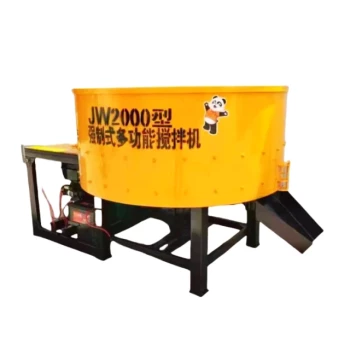Keeping the concrete moving in a cement mixer is essential to maintain its workability and prevent premature setting. This ensures the concrete remains homogeneous, avoids segregation, and retains its desired properties until it is poured. For large-scale projects, continuous mixing is particularly critical to meet quality standards and structural integrity requirements.
Key Points Explained:
-
Prevents Premature Setting
- Concrete begins to harden through a chemical process called hydration once water is added.
- Continuous mixing slows this process by maintaining movement, preventing early stiffening.
- If concrete sets too soon, it becomes unusable, leading to material waste and project delays.
-
Ensures Workability
- Workability refers to how easily concrete can be mixed, placed, and compacted.
- Moving the mixture prevents it from becoming too thick or stiff before reaching the construction site.
- Proper workability is crucial for achieving a smooth, even pour without voids or weak spots.
-
Maintains Homogeneity
- Without agitation, heavier aggregates can settle, while water and cement rise (segregation).
- Continuous mixing ensures a uniform distribution of all components, maintaining strength and durability.
- Segregated concrete loses structural integrity, leading to potential failures in the final product.
-
Prevents Heat Buildup
- Hydration generates heat, which can accelerate setting in large batches.
- Mixing helps dissipate this heat, keeping the temperature consistent throughout the mixture.
- Excessive heat can cause cracking or reduce long-term strength if not managed properly.
-
Critical for Large Projects
- Transporting concrete over long distances requires prolonged mixing to maintain quality.
- Ready-mix trucks rely on rotating drums to keep concrete in optimal condition until delivery.
- Stopping the mixer prematurely can lead to costly rejections or rework on-site.
By understanding these factors, contractors and purchasers can ensure they select the right cement mixer and mixing protocols for their projects, avoiding costly mistakes and ensuring durable, high-quality concrete structures.
Summary Table:
| Key Benefit | Explanation |
|---|---|
| Prevents Premature Setting | Slows hydration, avoiding early stiffening and material waste. |
| Ensures Workability | Keeps concrete pliable for easy pouring and compaction. |
| Maintains Homogeneity | Prevents aggregate settling and cement-water separation. |
| Controls Heat Buildup | Dissipates heat from hydration to avoid cracking. |
| Critical for Large Projects | Prolongs usability during transport for consistent quality. |
Need a reliable cement mixer for your project?
GARLWAY specializes in high-performance construction machinery, including durable cement mixers designed to maintain perfect consistency. Ensure your concrete stays workable and homogeneous—get a quote today or explore our solutions for contractors and large-scale projects!
Related Products
- HZS75 Concrete Batching Plant Cement Mixer Price Concrete Mixer Bunnings Mixing Plant
- Concrete Cement Mixer Machine Drum Mixer for Construction
- Auto Concrete Cement Mixer Machine New
- JZC1000 Industrial Concrete Mixer Machine Cement Mixer Price
- HZS25 Best Cement Mixer for Quick Mix Concrete at Bunnings
People Also Ask
- Can you mix mortar in a cement mixer? Pros, Cons & Best Practices
- How to start a concrete plant business? A Step-by-Step Guide to Building Your Construction Materials Venture
- Do you put water or cement in a cement mixer first? The Right Order for Perfect Concrete
- What can you mix in a cement mixer? Discover Its Versatile Uses
- What are the disadvantages of ready mixed concrete? Key Challenges Explained



















